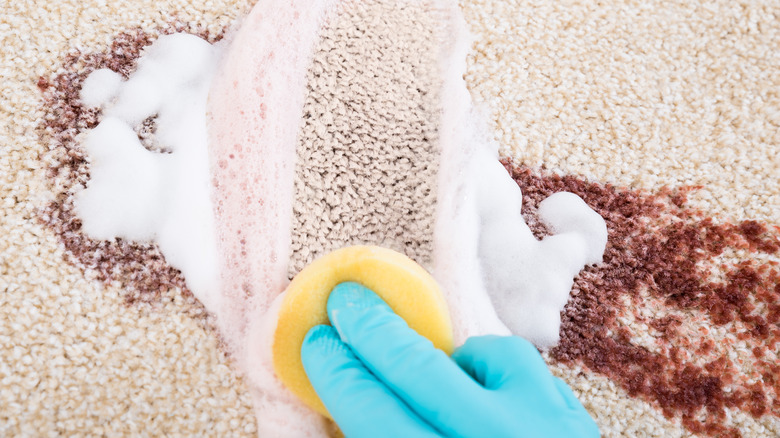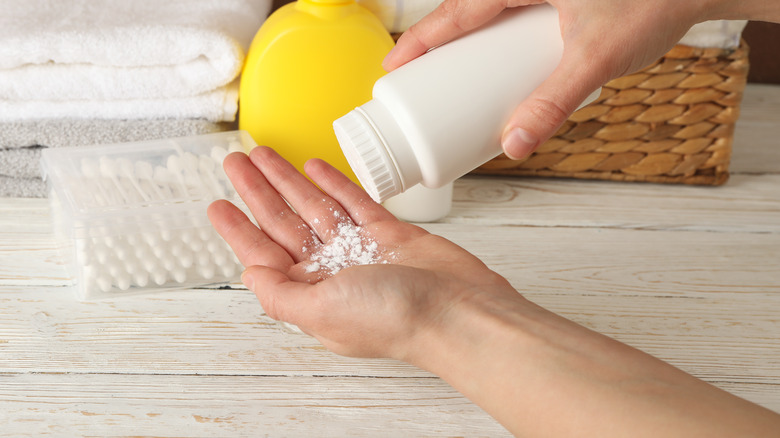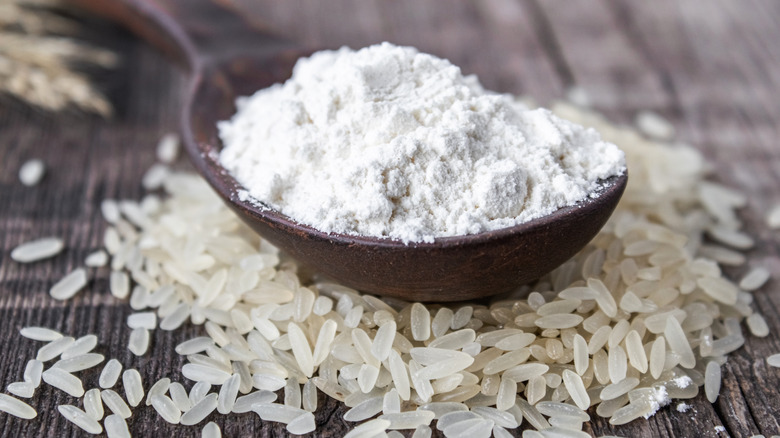Easily Remove Grease Stains With These Unexpected Household Staples
You never want to see grease stains anywhere in your home, but they seem to show up on your favorite shirt, dripped onto the carpet, or smeared across the counter. Removing them without making a bigger mess is tricky, and traditional cleaners may not get the job done.
Luckily, you can use a few household staples to remove grease from surfaces without leaving a mark. Instead of using chemical-based grease removers or putting the garment in the wash and hoping for the best, these items break down the grease so it rinses away. From chalk's ability to pull greasy messes from fabric to cornstarch's oil-absorbing powers, you can use these household staples to remove marks. Even better, cleaning experts stand behind many of these tricks and you may already have all the supplies you need on hand. The goal is to make cleaning grease as simple and effective as possible so your clothing and household items can look fresh and flawless.
Chalk soaks up grease from fabric
Chalk is very effective on oil and grease stains, removing them from your favorite shirt or pair of pants. First, get a piece of plain white chalk and put the greasy garment on a flat surface with cardboard between the top and bottom layers. Don't use colored chalk because the color may leach onto your clothing and make a bigger mess. Dab at the stain before gently rubbing the chalk right onto it, ensuring you cover the whole thing with a generous layer of dust. Give it about 10 to 15 minutes to absorb the grease, brush any extra dust off with a toothbrush, and wash like usual.
Chalk's primary makeup is calcium carbonate, which has a very high absorbency rate, making it effective for removing these stubborn stains. It works like cornstarch or baking soda to get rid of fats and oils. However, since chalk is solid, getting it right onto the grease spot is easy without getting it all over the clothing or spilling it.
Borax breaks down greasy stains
A simple combination of borax and water can remove grease from fabric items. Sprinkle a thick layer of borax onto the grease stain on your fabric. Then, either use a spray bottle with water or a wet rag to dampen the powder. Don't soak the fabric, and let it sit overnight for the best results. Then, wash the garment according to the care instructions on the tag.
Borax's chemical properties make it effective at getting rid of greases and oils. This naturally occurring mineral comes with a pH of around 9.24. This alkalinity is what breaks down the grease molecules, helping to release them from the fabric. When you put it on a stain and dampen the powder, you force a chemical reaction that creates a mild hydrogen peroxide. And, since peroxide is a bleaching agent, it can also help remove stains from fabric fibers.
Coca-Cola removes greasy driveway stains
Coca-Cola removes greasy stains from fabric and other surfaces. To use it, pour it directly onto the grease stains, ensuring you cover it. You want the liquid to saturate the stain and sit for several hours to help get into the grease. For older or larger stains, you may want to let it sit overnight before rinsing it with water. If the stain is still there, use a mild detergent and scrub to remove any traces.
The iconic soda has unique properties and ingredients that help it remove grease. The first, phosphoric acid, is a powerful cleaner because it's excellent at breaking down stains and dissolving grease molecules to make them more water-soluble. Also, the slight carbonation lifts grease from your driveway or clothing, helping you rinse it out. The results will vary based on the surface you use it on and how old the stain is.
Cornstarch absorbs oils from carpets and clothing
To remove greasy stains, try cornstarch. This trick works well on both carpet and clothing. All you have to do is sprinkle it right onto the stain, fully covering it. Let it sit for 15 to 20 minutes so it can absorb the grease. Then, set your vacuum to the carpet setting and do a few passes until you get it out of the fibers. Or, for clothing, gently brush or shake the excess cornstarch off before washing it as normal.
Corn starch can soak up several times its weight in oil and water and get into tiny spaces in your clothing or carpet fibers to pull the grease out. When you put it on a stain, the granules work like tiny sponges, soaking the oil away from the fibers or fabric into the powder. Once it finishes absorbing, you can easily remove it with the trapped grease. This makes the stain much less visible and stops the grease from sinking deeper.
Salt and rubbing alcohol break down fats
Salt and rubbing alcohol are a strong combination you can use to tackle greasy stains. Start by pouring a small amount of rubbing alcohol onto a clean, white cloth. Gently dab the cloth into the stain, ensuring you cover the whole spot. Then, get a pinch of table salt and sprinkle it generously to cover the alcohol-soaked stain. Let this mixture sit overnight so it has time to absorb the grease before using a soft brush to remove it. Finally, wash the items using the care instructions as a guide.
Rubbing alcohol is a solvent that breaks down the oils and fats in grease stains. Its molecular structure allows it to dissolve grease and loosen its bonds. Salt is an excellent absorbent, and its light granular texture gives it a big surface area to absorb grease and trap it. This combo helps you address the physical and chemical aspects of grease stains in one go.
Baby powder draws grease from fibers
You can remove grease stains with baby powder, including using it on various fabrics. Carefully sprinkle it over the whole stain, going slightly past the edges. Let it work for at least an hour or more as it absorbs the grease. Then, use a soft, clean cloth or a soft-bristled brush and carefully brush the baby powder into the trash. Ideally, most of the grease will go with it, making the stain look much lighter. This trick should also be safe to use on carpet and upholstery, and you can simply vacuum it up when you're done.
The base ingredient in baby powder is usually cornstarch or talcum powder, which makes for highly absorbent particles. They trap the grease inside their granular structures, reducing how visible the stain is while preventing the grease from sinking further in. Washing the fabric after dusting off the baby powder can remove any residual stain marks.
Eucalyptus oil breaks down grease and oil
Eucalyptus oil is a natural way to get various stains out of fabrics. To use this fragrant trick, put your grease-stained clothes on a flat surface. Then, pour a few drops of pure, undiluted eucalyptus oil onto the spot. Spread it slightly outside the edges of the stain so you don't have an odd ring. Work it into the fabric with light pressure using gloved fingers or a brush, and give it a few minutes to start breaking down the stain. Wash the item like you usually would to flush everything out.
This oil is a solvent and cleaning experts swear by it for breaking down greasy stains and residue. The oil interacts with the grease and will start to dissolve it while breaking the bonds with the fabric. Plus, as a bonus, the antibacterial properties in the oil will kill germs, and the fragrance will leave a pleasant scent in your laundry.
Rice flour strips grease from hard surfaces and fabric
Rice flour can also help you remove grease from fabrics and hard surfaces. Start by sprinkling a thin layer of flour onto the stain to cover it. For newer stains, let the flour sit for a few hours. However, for older ones, you'll want to leave it at least overnight. Then, use a dry cloth or soft brush to remove the flour. Ideally, you'll see small clumps when you remove the flour meaning it soaked up the grease. Wash your fabric or clean your hard surfaces like you usually would.
Rice flour has very finely ground rice as the base ingredient. Because it's very fine, it has a much bigger surface area, and it can absorb more grease. Putting it on the stain removes the grease from the surface and transfers it into the rice flour. Then, the starch content binds the grease molecules to create clumps you can brush off.
Shaving cream emulsifies grease
Did you know you can use shaving cream to remove greasy stains? First, you'll need to buy a non-gel, plain shaving cream without any scent or colors because it could stain whatever you're cleaning. Squirt a dollop of shaving cream onto the stain, covering it and making sure it has direct contact. Allow it to sit for 30 to 45 minutes to give it time to emulsify the grease. Don't rub or scrub at it, and toss the garment into the wash. For carpet, absorb as much grease as possible with a dry cloth, apply the shaving cream, and then blot at it after 15 to 20 minutes with a damp towel.
The shaving cream's composition is what makes it great for spot-cleaning grease. Its base is a type of soap that emulsifies the grease. Since grease is oil-based, it repels water and makes it hard to pull from fabric or carpet. The shaving cream breaks down grease molecules, loosening them. Then, it's suspended in the shaving cream, and you can wash it away. However, you should always do a spot test before you use it in a visible area to ensure it doesn't bleach anything.
Toothpaste lifts grease from fabric and tile
Toothpaste is terrific for removing grease stains from kitchen tile and fabric. Make sure to use white toothpaste, avoiding gel or colored options because they can discolor whatever you're cleaning. Squeeze a small amount onto the grease, covering the spot. Work the toothpaste into the stain to cover it and allow it to work for about 10 to 15 minutes. Then, carefully wipe down the area if you're cleaning a hard surface. If it's fabric, toss it into the washer. Also, test a small, hidden spot on any fabric first to ensure it doesn't bleach.
Toothpaste has very mild abrasives, like silica and calcium carbonate, and they help you gently scrub at the grease to lift it. It also has surfactants that reduce the surface tension between the fabric and grease. This breaks down grease molecules and helps you rinse them away much easier.










